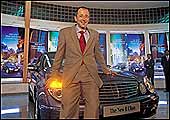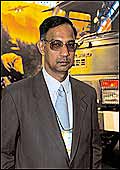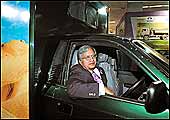 |
ULF NORDQVIST/MANAGING
DIRECTOR/VOLVO INDIA
"As Indian
become more aware of issues like environment impact and safety,
players complying to international standards will become more
popular" |
Last
fortnight Hans Michael Huber, Managing Director and CEO, DaimlerChrysler
India, was preparing the ground to open bookings for the Maybach,
the exclusive luxury car that's back into production after 60 years.
Of the 1,000-odd Maybachs that will be produced, a small but significant
number will be sold in India, at Rs 4.5-5 crore (depending on the
accessories you opt for). You'd naturally expect Huber and his team
to be charged up about the Maybach launch-and, by the way, also
about the ongoing Mercedes Trophy Golf Tournament 2004, which will
culminate with the World Final in Stuttgart, Germany in September-but
there's still another reason for the infective exuberance at DaimlerChrysler's
Pimpri works in Pune. The German auto major, more synonymous with
the sedan with the three-pointed star, is currently studying the
feasibility of putting its trucks and buses-of which it is the world's
largest manufacturer-on Indian roads. "We are studying which
product we should bring into the country, what kind of volumes we
should be dealing in, and how we should go about distributing our
vehicles. But I am pretty convinced there is a market now in India
for the kind of heavy-duty vehicles we make," says Huber.
 |
HANS MICHAEL
HUBER/MD & CEO/DAIMLERCHRYSLER INDIA
"I am pretty
convinced there is a market now in India for the kind of heavy-duty
vehicles we make" |
Still in Pune, a handpicked selection of the
Tata Motors' workforce is working on a project codenamed "Truck
of the Future." To be launched by 2007, the truck will have
a world-class modular cab that's being styled in Italy. The Tatas
are in talks with Cummins to supply high horsepower engines, of
even up to 550 hp (the norm currently is 200 hp). For axles and
gears too, India's largest maker of CVs is in discussions with ancillary
makers, as also for brakes, wiring and harnesses. The frame of the
truck will be developed in-house. In the shorter term-that is, in
a year-Tata Motors hopes to leverage the Daewoo acquisition to launch
trucks in the 200-400 HP range. Not to be left behind, India's No
2 CV player, Ashok Leyland, is preparing to launch its "NEWGEN"
range of CVs by 2005, which will be powered by a contemporary, fuel-efficient
eight-litre J engine, with the most modern gearbox, propeller shafts,
axles and frames. A full-width cab meeting EC safety norms for frontal
impact and roof crash has been developed in-house.
| BUS (Y) BODIES |
 If
the commercial vehicles (CVs) market is on the fast track, the
potential that exists in the bus segment is truly mind-boggling.
Consider: Currently, buses account for just 12-13 per cent of
the entire CVs sector. In China they account for half of the
heavy vehicles market. Ravikant of Tata Motors expects buses
to account for 30 per cent of CVs in the near future. If
the commercial vehicles (CVs) market is on the fast track, the
potential that exists in the bus segment is truly mind-boggling.
Consider: Currently, buses account for just 12-13 per cent of
the entire CVs sector. In China they account for half of the
heavy vehicles market. Ravikant of Tata Motors expects buses
to account for 30 per cent of CVs in the near future.
That's exactly why virtually every CV player is jostling
for a piece of this rapidly-burgeoning pie. Volvo took the
plunge with its B7R a couple of years ago. Though nearly 21,000
buses are sold in the country every year, nearly 20,300 of
them are sold in the less than Rs 20 lakh category. Volvo's
B7R is priced way beyond, at Rs 52 lakh (for the basic version).
That price tag may appear outrageous, but it provides ample
room for additional revenue generation. The B7R is 12 metres
long as against the conventional Indian bus that's 10.5 metres.
"So instead of just 35 seats, Volvo can provide 10 more,"
points out Akash Passey, GM, Volvo India.
Also talking about "premium transportation" is
DaimlerChrysler India; the Mercedes company will, besides
luxury coaches for inter and intra-city travel, focus sharply
on mini-buses (15-seaters) for resorts and hotels. Tata Motors,
on the other hand, plans to go the whole hog, with buses right
from 12 to 100-seaters. Hop on and enjoy the ride.
|
Even as DaimlerChrysler India goes about its
feasibility studies, and the existing players draw out their plans
for a gung-ho future, another German truck major, Maschininenfabrik
Augsburg Nurnberg (man), has been signed on by the Pune-based Bajaj
Tempo as an exclusive technical collaborator to help Chairman Abhay
Firodia roll out medium and heavy commercial vehicles by 2005. Unlike
DaimlerChrysler, which plans to flag off heavy-vehicle operations
via imports, Bajaj Tempo plans to invest in manufacturing facilities
for multi-axle vehicles, tractor trailers and also for engines in
the 155-410 hp range as well as transmissions. Finally, don't forget
Volvo India, which entered the domestic market in 1998, and which
has gained a head start in the race for higher-tech, new-generation
trucks (and buses), and is now fine-tuning its strategy to bring
in the volumes.
It's Spring Time
It's never been so good for the highly-cyclical
CV industry. And, what's more, it's never promised to be as good,
either. Since its last peak in 1996-97, the sector has only contracted;
until 2003-04, a year in which the industry has so far been racing
at a growth rate of close to 40 per cent. Now an upcycle in the
CV industry typically lasts three years, but what's making manufacturers
even more upbeat about the longer term is the frenzied road construction
work that's under way coupled with bullish projections for industrial
activity (which in turn will call for busier freight movement).
For one, there's the Golden Quadrilateral project that's linking
the north-south and east-west corridors across 7,300 km. For another
there's the Prime Minister's Gram Sadak Yogana that promises to
provide comprehensive rural road connectivity. "These roads
will call for new kinds of vehicles, and that's why it's only a
matter of time before new global players (Mitsubishi, Renault, and
Nissan) sense the opportunity in the Indian CV market," says
Ravikant, Executive Director (Commercial Vehicle Business Unit),
Tata Motors. Adds R. Seshasayee, MD, Ashok Leyland: "The modern
infrastructure being built supports high-productivity vehicles,
allowing operators to realise their efficiency and revenue potential."
 |
R. SESHASAYEE/MD/ASHOK
LEYLAND
"Modern infrastructure
supports high-productivity vehicles. allowing operators to realise
their efficiency and revenue potential" |
Simply put, what all this infrastructure-creation
means is that operators will now be able to ferry more tonnage over
longer distances faster. That's why, as Huber points out, there
is a new buying pattern emerging amongst truck owners: The focus
is shifting from the purchase price to cost per kilometre of transport.
"What's important is how many kilometres the trucks can go
without servicing, with reduced tyre wear etc," he explains.
Volvo, which has been around for five years, perhaps sensed the
impending turnaround in Indian infrastructure first. The Swedish
auto giant has two basic trucks, the FM 9 (which has three versions)
and the FM 12 (two versions) in the Rs 30-50 lakh range. "As
Indians become more aware of issues like environment impact-it's
perhaps the only Indian manufacturer that's Euro III compliant-and
safety, players complying to international standards will become
more popular," says Ulf Nordqvist, Managing Director of Volvo
India. Competitors are quick to point out that Volvo's next-gen
products are not suited to Indian roads in their current condition.
What's more they're also not equipped to deal with overloading-a
necessity currently since turnaround times are long-and hence result
in huge warranty costs, points out one competitor. Nordqvist, however,
maintains that 65 per cent of his sales come from repeat purchases,
''Such a high repeat purchase indicates that our customers see value
in our offerings.''
 |
RAVIKANT/EXECUTIVE
DIRECTOR (COMMERCIAL VEHICLE BUSINESS UNIT)/TATA MOTORS
"It's only
a matter of time before new global players sense the opportunity
in the Indian CV market" |
The new trucks for their part promise to change
the face of transportation: One, the trucks will be able to carry
much more, up to 40 tonnes, double what most CVs can carry today,
and the engines will be packed with more horse power up to 350-400
hp against the current norm of 200 hp. Result? Faster turnarounds,
and consequently lesser overloading.
Clearly, in the years ahead, India's CV makers
will change the way goods (and people, see, Bus(y) Bodies) are transported
across the length and breadth of the country. One fallout of this
progress, though, will be that the industry just can't continue
to grow at 35-40 per cent rates for ever. The reason is simple:
As the tonnage of vehicles increases, roads get better and vehicles
faster, you'd naturally need less of them. But then, once turnaround
times decrease, overloading becomes less of a hazard, and operators
begin getting more bang per kilometre for their investments, percentage
growth is only secondary. Once all that happens, India's CV industry
would have finally arrived.
|
